Scandium Decoration of Boron Doped Porous Graphene for High-Capacity Hydrogen Storage
Abstract
1. Introduction
2. Calculation Details
3. Results and Discussion
3.1. Single B Atom Doped Stable Position
3.2. Single Sc Atom Modified B-PG System
3.2.1. Adsorption Structure of Single Sc Atom Modified B-PG
3.2.2. The Adsorption of H2 on a Single Sc Atom Modified B-PG System
3.3. Two Sc Atoms Modified B-PG System
3.3.1. Adsorption Structure of two Sc Atoms Modified B-PG
3.3.2. Hydrogen Storage of two Sc Atoms Modified B-PG
4. Conclusions
Author Contributions
Funding
Acknowledgments
Conflicts of Interest
References
- Lei, Y.; Shevlin, S.A.; Zhu, W.; Guo, Z.X. Hydrogen-induced magnetization and tunable hydrogen storage in graphitic structures. Phys. Rev. B 2008, 77. [Google Scholar] [CrossRef]
- Du, A.; Zhu, Z.; Smith, S.C. Multifunctional Porous Graphene for Nanoelectronics and Hydrogen Storage: New Properties Revealed by First Principle Calculations. J. Am. Chem. Soc. 2010, 132, 2876–2877. [Google Scholar] [CrossRef] [PubMed]
- Wang, Y.; Meng, Z.; Liu, Y.; You, D.; Wu, K.; Lv, J.; Wang, X.; Deng, K.; Rao, D.; Lu, R. Lithium decoration of three dimensional boron-doped graphene frameworks for high-capacity hydrogen storage. Appl. Phys. Lett. 2015, 106, 63901. [Google Scholar] [CrossRef]
- Hussain, T.; Pathak, B.; Ramzan, M.; Maark, T.A.; Ahuja, R. Calcium doped graphane as a hydrogen storage material. Appl. Phys. Lett. 2012, 100, 183902. [Google Scholar] [CrossRef]
- Song, N.; Wang, Y.; Zheng, Y.; Zhang, J.; Xu, B.; Sun, Q.; Jia, Y. New template for Li and Ca decoration and hydrogen adsorption on graphene-like SiC: A first-principles study. Comput. Mater. Sci. 2015, 99, 150–155. [Google Scholar] [CrossRef]
- Gao, Y.; Zhao, N.; Li, J.; Liu, E.; He, C.; Shi, C. Hydrogen spillover storage on Ca-decorated graphene. Int. J. Hydrog. Energy 2012, 37, 11835–11841. [Google Scholar] [CrossRef]
- Seenithurai, S.; Kodi Pandyan, R.; Vinodh Kumar, S.; Mahendran, M. H2 adsorption in Ni and passivated Ni doped 4 Å single walled carbon nanotube. Int. J. Hydrog. Energy 2013, 38, 7376–7381. [Google Scholar] [CrossRef]
- Bhattacharya, A.; Bhattacharya, S.; Majumder, C.; Das, G.P. Transition-Metal Decoration Enhanced Room-Temperature Hydrogen Storage in a Defect-Modulated Graphene Sheet. J. Phys. Chem. C 2010, 114, 10297–10301. [Google Scholar] [CrossRef]
- Ramos-Castillo, C.M.; Reveles, J.U.; Cifuentes-Quintal, M.E.; Zope, R.R.; de Coss, R. Ti4- and Ni4-Doped Defective Graphene Nanoplatelets as Efficient Materials for Hydrogen Storage. J. Phys. Chem. C 2016, 120, 5001–5009. [Google Scholar] [CrossRef]
- Ramos-Castillo, C.M.; Reveles, J.U.; Zope, R.R.; de Coss, R. Palladium Clusters Supported on Graphene Monovacancies for Hydrogen Storage. J. Phys. Chem. C 2015, 119, 8402–8409. [Google Scholar] [CrossRef]
- Lebon, A.; Carrete, J.; Gallego, L.J.; Vega, A. Ti-decorated zigzag graphene nanoribbons for hydrogen storage. A van der Waals-corrected density-functional study. Int. J. Hydrog. Energy 2015, 40, 4960–4968. [Google Scholar] [CrossRef]
- Chu, S.; Hu, L.; Hu, X.; Yang, M.; Deng, J. Titanium-embedded graphene as high-capacity hydrogen-storage media. Int. J. Hydrog. Energy 2011, 36, 12324–12328. [Google Scholar] [CrossRef]
- Liu, Y.; Ren, L.; He, Y.; Cheng, H.-P. Titanium-decorated graphene for high-capacity hydrogen storage studied by density functional simulations. J. Phys. Condens. Matter 2010, 22, 445301. [Google Scholar] [CrossRef]
- Chi, S.-S.; Liu, Y.; Zhao, N.; Guo, X.; Nan, C.-W.; Fan, L.-Z. Solid polymer electrolyte soft interface layer with 3D lithium anode for all-solid-state lithium batteries. Energy Storage Mater. 2019, 17, 309–316. [Google Scholar] [CrossRef]
- Luo, Z.; Fan, X.; Pan, R.; An, Y. A first-principles study of Sc-decorated graphene with pyridinic-N defects for hydrogen storage. Int. J. Hydrog. Energy 2017, 42, 3106–3113. [Google Scholar] [CrossRef]
- Zhang, H.; Xia, G.; Zhang, J.; Sun, D.; Guo, Z.; Yu, X. Graphene-Tailored Thermodynamics and Kinetics to Fabricate Metal Borohydride Nanoparticles with High Purity and Enhanced Reversibility. Adv. Energy Mater. 2018, 8, 1702975. [Google Scholar] [CrossRef]
- Chong, L.; Zeng, X.; Ding, W.; Liu, D.-J.; Zou, J. NaBH4 in “Graphene Wrapper:” Significantly Enhanced Hydrogen Storage Capacity and Regenerability through Nanoencapsulation. Adv. Mater. 2015, 27, 5070–5074. [Google Scholar] [CrossRef] [PubMed]
- Xia, G.; Tan, Y.; Chen, X.; Sun, D.; Guo, Z.; Liu, H.; Ouyang, L.; Zhu, M.; Yu, X. Monodisperse Magnesium Hydride Nanoparticles Uniformly Self-Assembled on Graphene. Adv. Mater. 2015, 27, 5981–5988. [Google Scholar] [CrossRef] [PubMed]
- Yang, H.; Lombardo, L.; Luo, W.; Kim, W.; Züttel, A. Hydrogen storage properties of various carbon supported NaBH4 prepared via metathesis. Int. J. Hydrog. Energy 2018, 43, 7108–7116. [Google Scholar] [CrossRef]
- Venkataramanan, N.S.; Suvitha, A.; Mizuseki, H.; Kawazoe, Y. A theoretical study of the effects of transition metal dopants on the adsorption and dissociation of hydrogen on nickel clusters. Int. J. Quantum Chem. 2013, 113, 1940–1948. [Google Scholar] [CrossRef]
- Rojas, M.I.; Leiva, E.P.M. Density functional theory study of a graphene sheet modified with titanium in contact with different adsorbates. Phys. Rev. B 2007, 76. [Google Scholar] [CrossRef]
- Faye, O.; Szpunar, J.A.; Szpunar, B.; Beye, A.C. Hydrogen adsorption and storage on Palladium—Functionalized graphene with NH-dopant: A first principles calculation. Appl. Surf. Sci. 2017, 392, 362–374. [Google Scholar] [CrossRef]
- Durgun, E.; Ciraci, S.; Yildirim, T. Functionalization of carbon-based nanostructures with light transition-metal atoms for hydrogen storage. Phys. Rev. B 2008, 77. [Google Scholar] [CrossRef]
- Kim, G.; Jhi, S.-H.; Park, N.; Louie, S.G.; Cohen, M.L. Optimization of metal dispersion in doped graphitic materials for hydrogen storage. Phys. Rev. B 2008, 78. [Google Scholar] [CrossRef]
- Huang, H.-W.; Hsieh, H.-J.; Lin, I.-H.; Tong, Y.-J.; Chen, H.-T. Hydrogen Adsorption and Storage in Heteroatoms (B, N) Modified Carbon-Based Materials Decorated with Alkali Metals: A Computational Study. J. Phys. Chem. C 2015, 119, 7662–7669. [Google Scholar] [CrossRef]
- Nachimuthu, S.; Lai, P.-J.; Jiang, J.-C. Efficient hydrogen storage in boron doped graphene decorated by transition metals—A first-principles study. Carbon 2014, 73, 132–140. [Google Scholar] [CrossRef]
- Liu, W.; Liu, Y.; Wang, R. Prediction of hydrogen storage on Y-decorated graphene: A density functional theory study. Appl. Surf. Sci. 2014, 296, 204–208. [Google Scholar] [CrossRef]
- Tokarev, A.; Avdeenkov, A.V.; Langmi, H.; Bessarabov, D.G. Modeling hydrogen storage in boron-substituted graphene decorated with potassium metal atoms: Hydrogen storage in boron-substituted graphene with potassium atoms. Int. J. Energy Res. 2015, 39, 524–528. [Google Scholar] [CrossRef]
- Beheshti, E.; Nojeh, A.; Servati, P. A first-principles study of calcium-decorated, boron-doped graphene for high capacity hydrogen storage. Carbon 2011, 49, 1561–1567. [Google Scholar] [CrossRef]
- Wang, H.; Zhou, Y.; Wu, D.; Liao, L.; Zhao, S.; Peng, H.; Liu, Z. Synthesis of Boron-Doped Graphene Monolayers Using the Sole Solid Feedstock by Chemical Vapor Deposition. Small 2013, 9, 1316–1320. [Google Scholar] [CrossRef]
- Rangel, E.; Ramírez-Arellano, J.M.; Carrillo, I.; Magana, L.F. Hydrogen adsorption around lithium atoms anchored on graphene vacancies. Int. J. Hydrog. Energy 2011, 36, 13657–13662. [Google Scholar] [CrossRef]
- Choudhary, A.; Malakkal, L.; Siripurapu, R.K.; Szpunar, B.; Szpunar, J. First principles calculations of hydrogen storage on Cu and Pd-decorated graphene. Int. J. Hydrog. Energy 2016, 41, 17652–17656. [Google Scholar] [CrossRef]
- Bieri, M.; Treier, M.; Cai, J.; Aït-Mansour, K.; Ruffieux, P.; Gröning, O.; Gröning, P.; Kastler, M.; Rieger, R.; Feng, X.; et al. Porous graphenes: two-dimensional polymer synthesis with atomic precision. Chem. Commun. 2009, 6919–6921. [Google Scholar] [CrossRef] [PubMed]
- Huang, C.; Wu, H.; Deng, K.; Tang, W.; Kan, E. Improved permeability and selectivity in porous graphene for hydrogen purification. Phys Chem Chem Phys 2014, 16, 25755–25759. [Google Scholar] [CrossRef]
- Reunchan, P.; Jhi, S.-H. Metal-dispersed porous graphene for hydrogen storage. Appl. Phys. Lett. 2011, 98, 93103. [Google Scholar] [CrossRef]
- Yuan, L.; Chen, Y.; Kang, L.; Zhang, C.; Wang, D.; Wang, C.; Zhang, M.; Wu, X. First-principles investigation of hydrogen storage capacity of Y-decorated porous graphene. Appl. Surf. Sci. 2017, 399, 463–468. [Google Scholar] [CrossRef]
- Lu, R.; Rao, D.; Meng, Z.; Zhang, X.; Xu, G.; Liu, Y.; Kan, E.; Xiao, C.; Deng, K. Boron-substituted graphyne as a versatile material with high storage capacities of Li and H2: a multiscale theoretical study. Phys. Chem. Chem. Phys. 2013, 15, 16120. [Google Scholar] [CrossRef]
- Lu, R.; Rao, D.; Lu, Z.; Qian, J.; Li, F.; Wu, H.; Wang, Y.; Xiao, C.; Deng, K.; Kan, E.; et al. Prominently Improved Hydrogen Purification and Dispersive Metal Binding for Hydrogen Storage by Substitutional Doping in Porous Graphene. J. Phys. Chem. C 2012, 116, 21291–21296. [Google Scholar] [CrossRef]
- Sun, J.; Wang, H.-T.; He, J.; Tian, Y. Ab initio investigations of optical properties of the high-pressure phases of ZnO. Phys. Rev. B 2005, 71. [Google Scholar] [CrossRef]
- Rao, D.; Lu, R.; Meng, Z.; Wang, Y.; Lu, Z.; Liu, Y.; Chen, X.; Kan, E.; Xiao, C.; Deng, K.; et al. Electronic properties and hydrogen storage application of designed porous nanotubes from a polyphenylene network. Int. J. Hydrog. Energy 2014, 39, 18966–18975. [Google Scholar] [CrossRef]
- Rao, D. Improve hydrogen storage capacities of several porous materials. Ph.D. Thesis, Nanjing University of Science Technology, Nanjing, China, 2013; p. 68. [Google Scholar]
- Chen, Y.; Wang, J.; Yuan, L.; Zhang, M.; Zhang, C. Sc-Decorated Porous Graphene for High-Capacity Hydrogen Storage: First-Principles Calculations. Materials 2017, 10, 894. [Google Scholar] [CrossRef] [PubMed]
- Yuan, L.; Kang, L.; Chen, Y.; Wang, D.; Gong, J.; Wang, C.; Zhang, M.; Wu, X. Hydrogen storage capacity on Ti-decorated porous graphene: First-principles investigation. Appl. Surf. Sci. 2018, 434, 843–849. [Google Scholar] [CrossRef]
- Knick, C.R. Modeling the Exfoliation Rate of Graphene Nanoplatelet Production and Application for Hydrogen Storage. Master’s Thesis, Wright State University, Dayton, OH, USA, 2012; pp. 52–60. [Google Scholar]
- Ao, Z.; Dou, S.; Xu, Z.; Jiang, Q.; Wang, G. Hydrogen storage in porous graphene with Al decoration. Int. J. Hydrog. Energy 2014, 39, 16244–16251. [Google Scholar] [CrossRef]
- Nam, H.; Jang, S.; Lee, W. Strategies for the Modification of Adhesion at Graphene/Al Interfaces: A First Principles Study. J. Nanosci. Nanotechnol. 2014, 14, 7674–7678. [Google Scholar] [CrossRef] [PubMed]
- Chen, M.; Yang, X.-B.; Cui, J.; Tang, J.-J.; Gan, L.-Y.; Zhu, M.; Zhao, Y.-J. Stability of transition metals on Mg (0001) surfaces and their effects on hydrogen adsorption. Int. J. Hydrog. Energy 2012, 37, 309–317. [Google Scholar] [CrossRef]
- Zhang, Z.W.; Li, J.C.; Jiang, Q. Hydrogen Adsorption on Eu/SWCNT Systems: A DFT Study. J. Phys. Chem. C 2010, 114, 7733–7737. [Google Scholar] [CrossRef]
- Sahaym, U.; Norton, M.G. Advances in the application of nanotechnology in enabling a “hydrogen economy”. J. Mater. Sci. 2008, 43, 5395–5429. [Google Scholar] [CrossRef]
Sample Availability: Samples of the compounds are not available from the authors. |
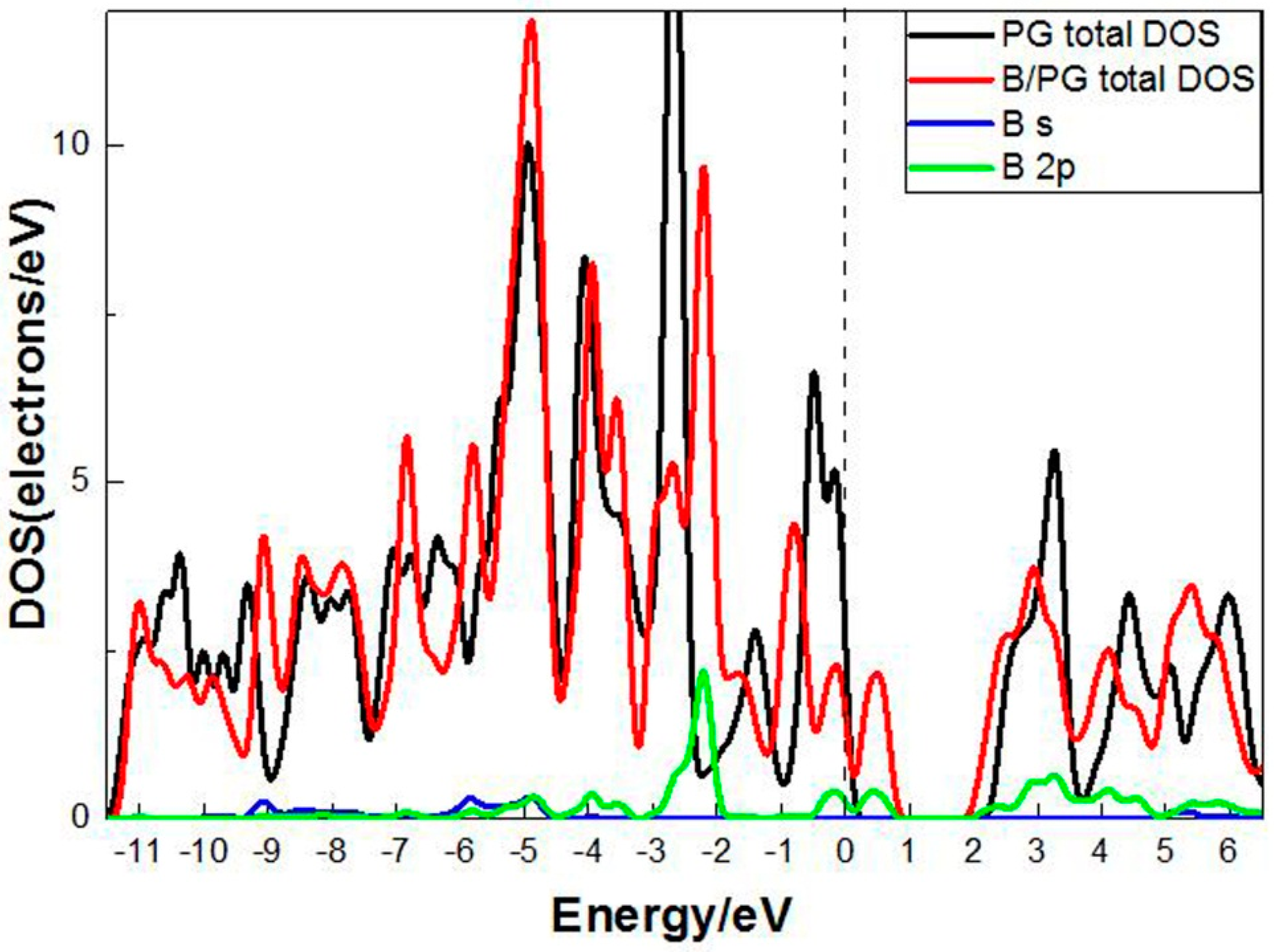
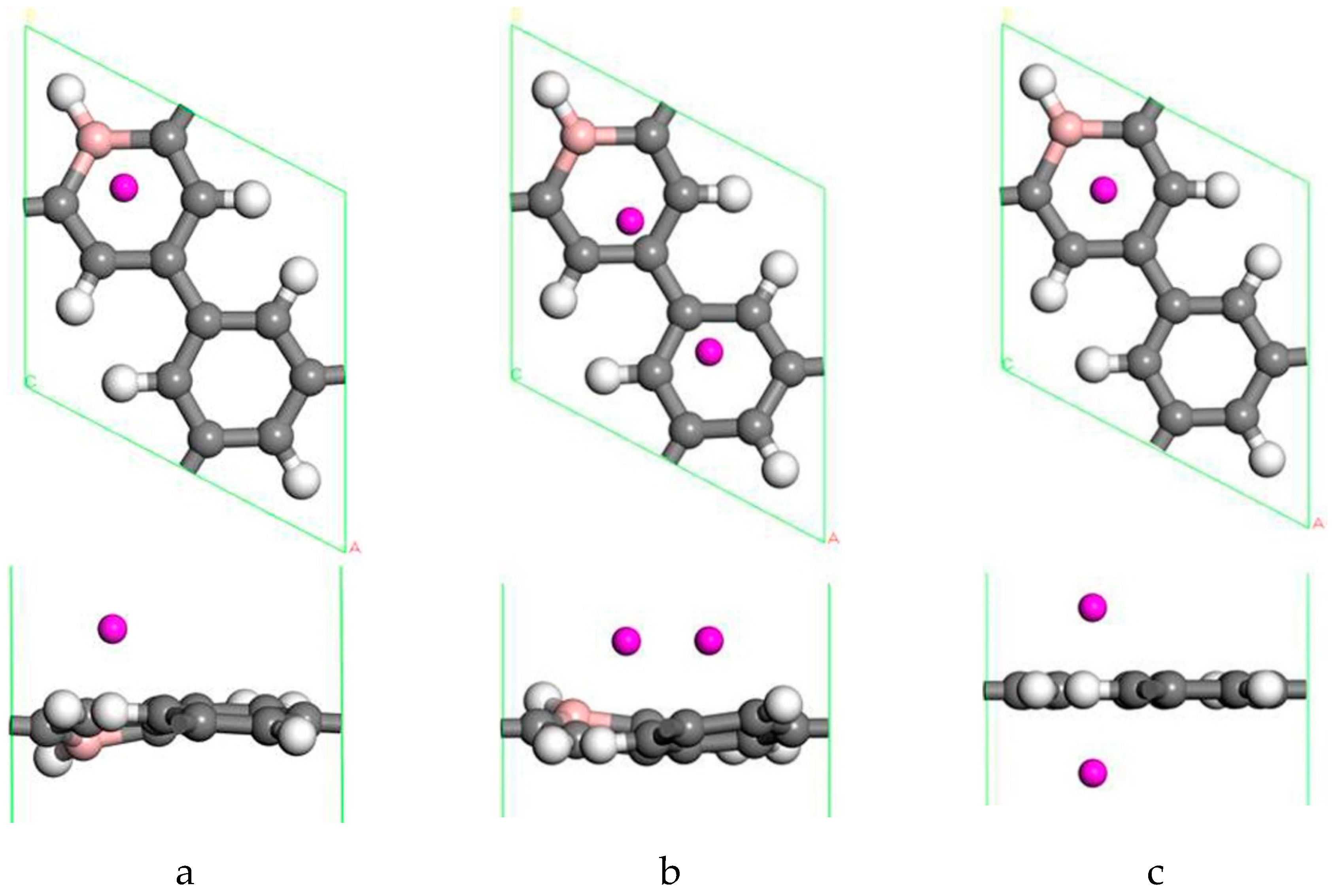

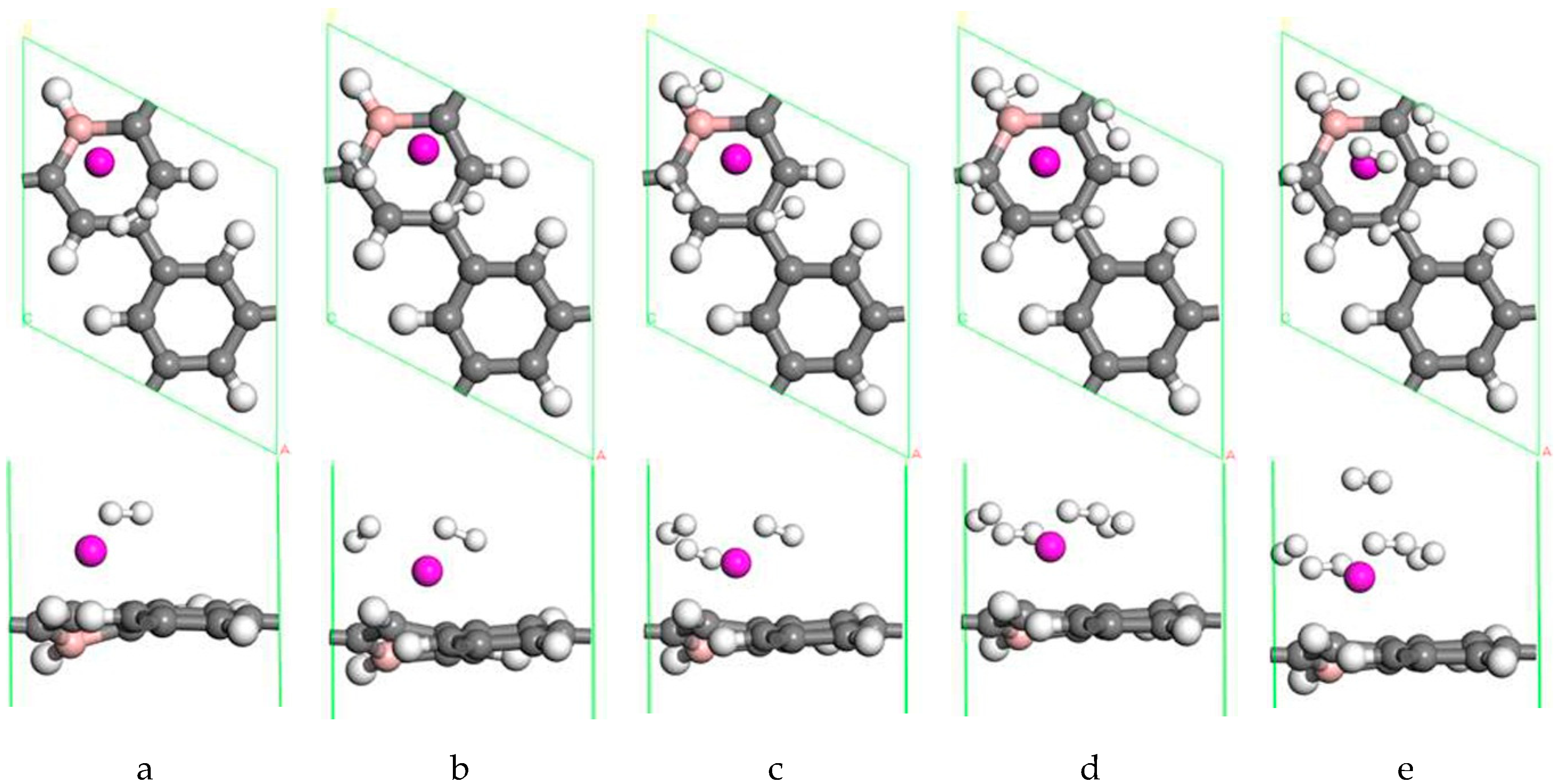
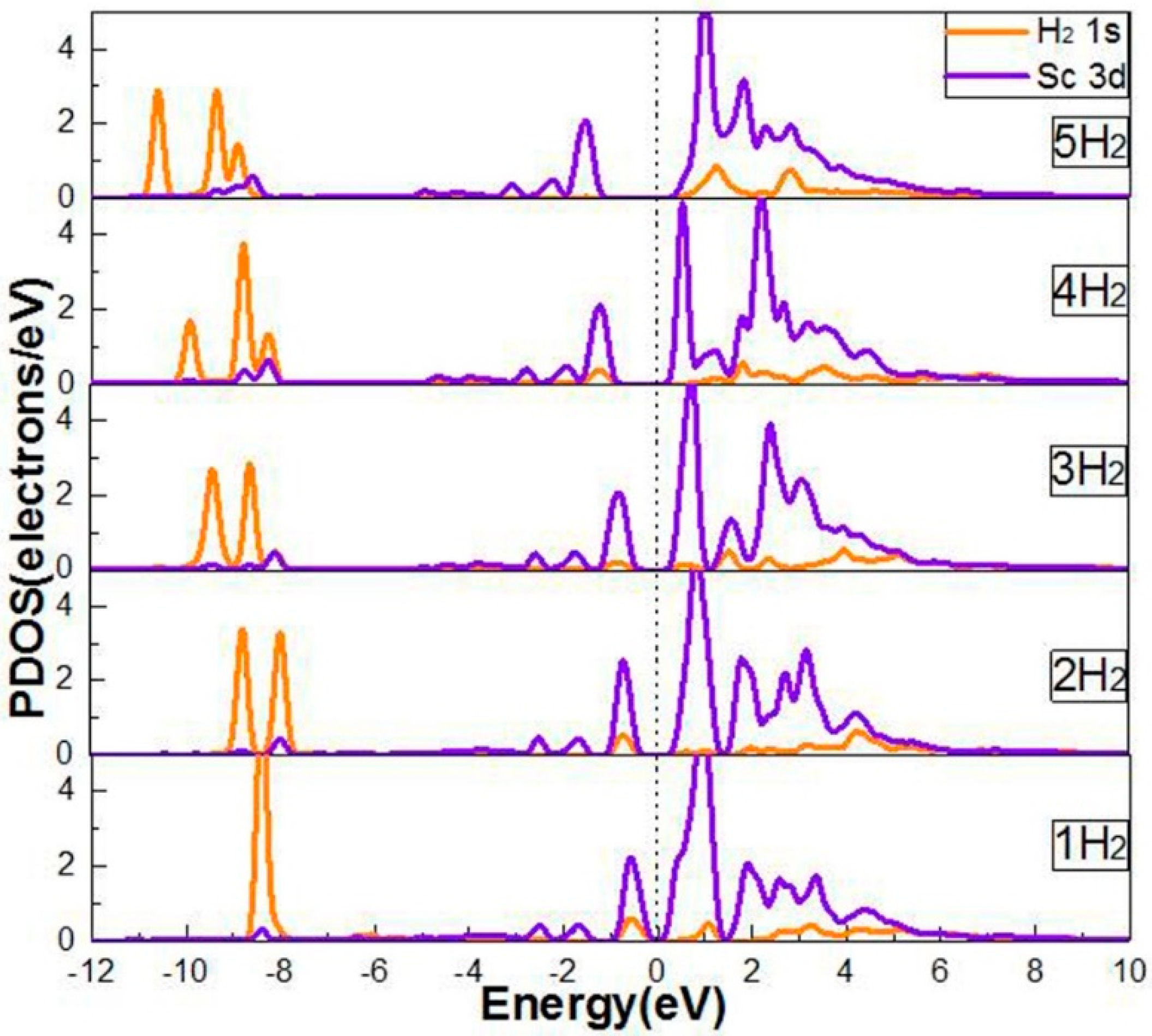
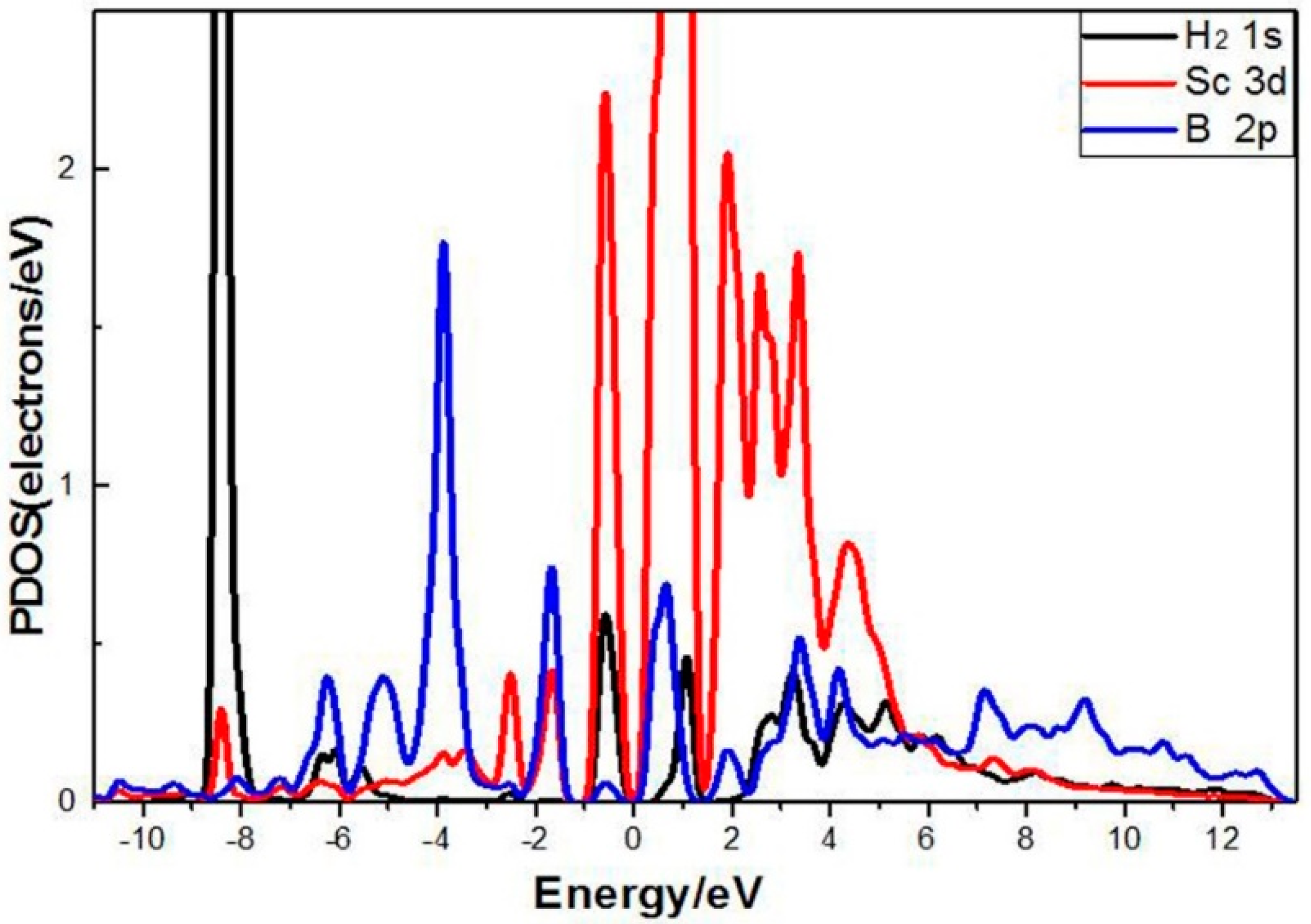
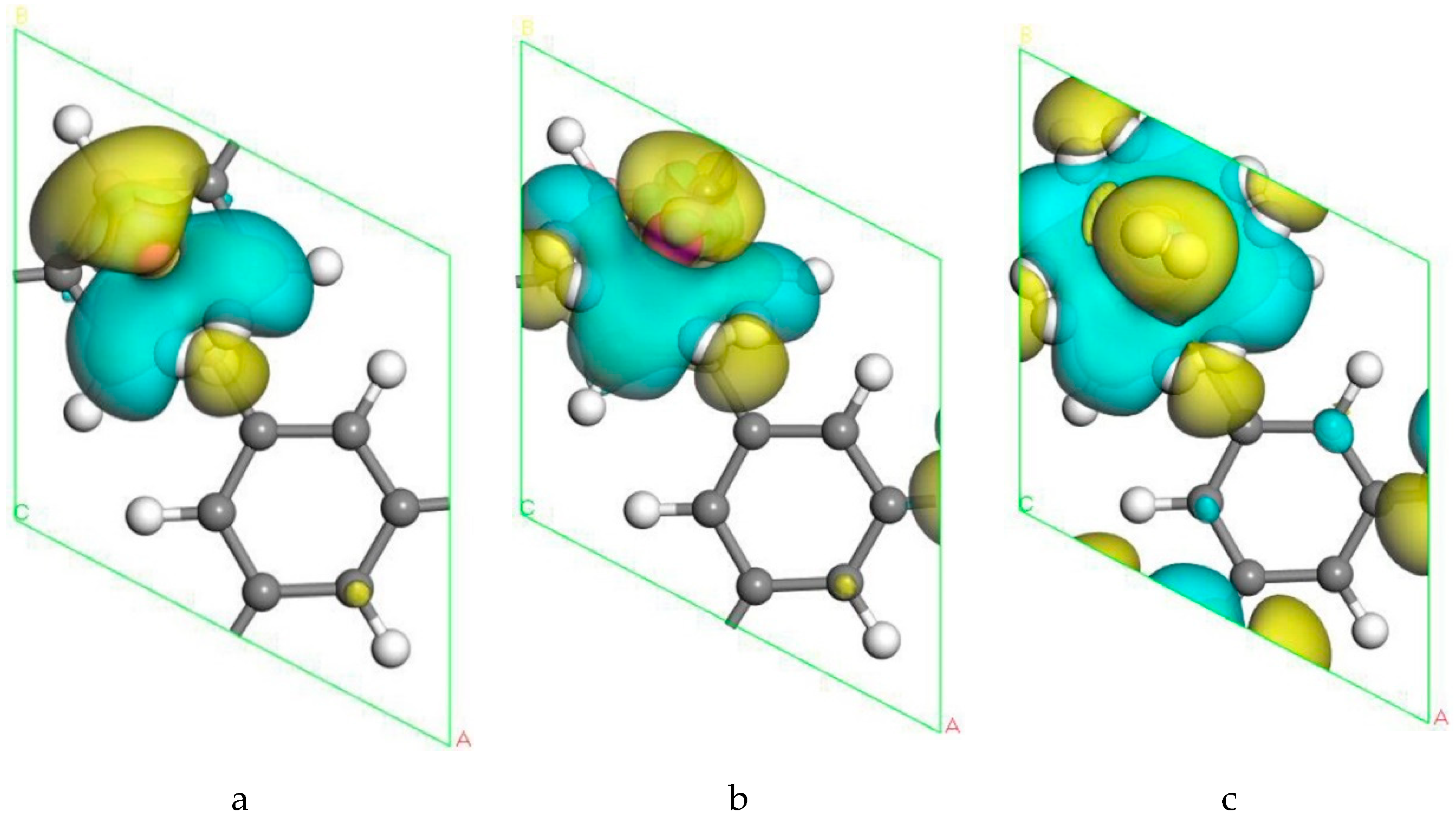
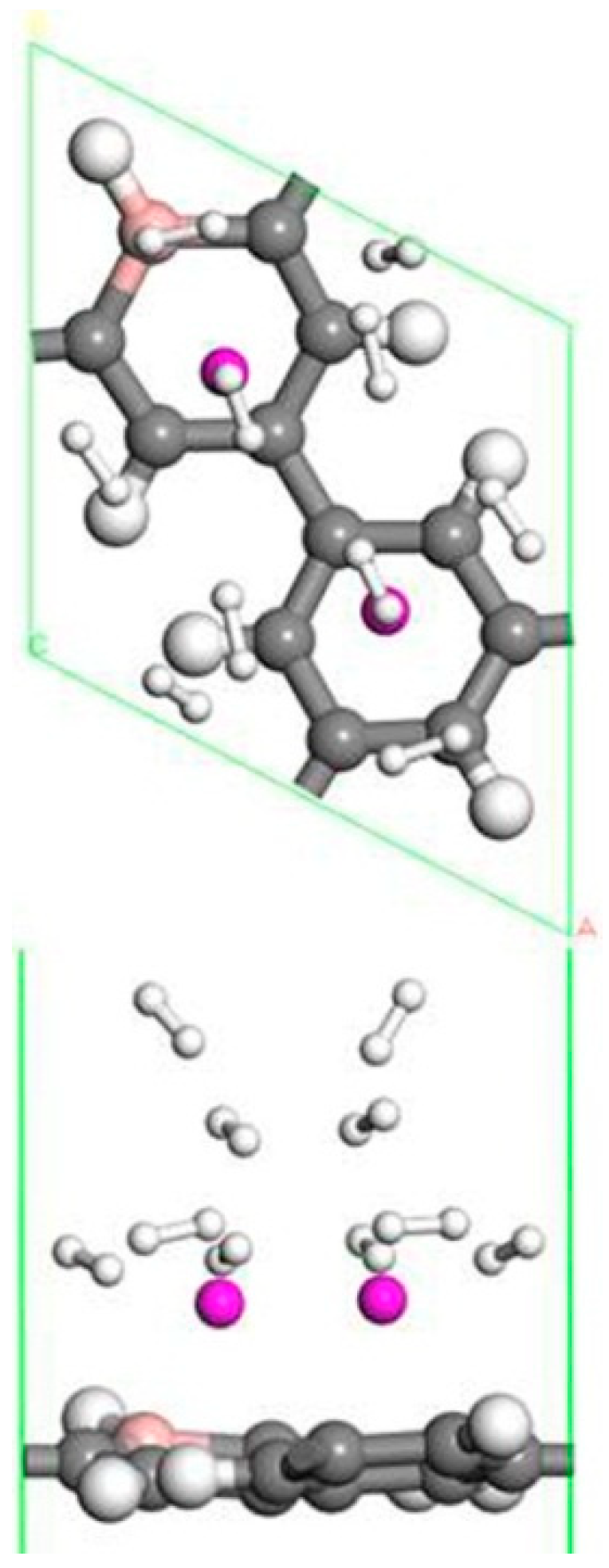
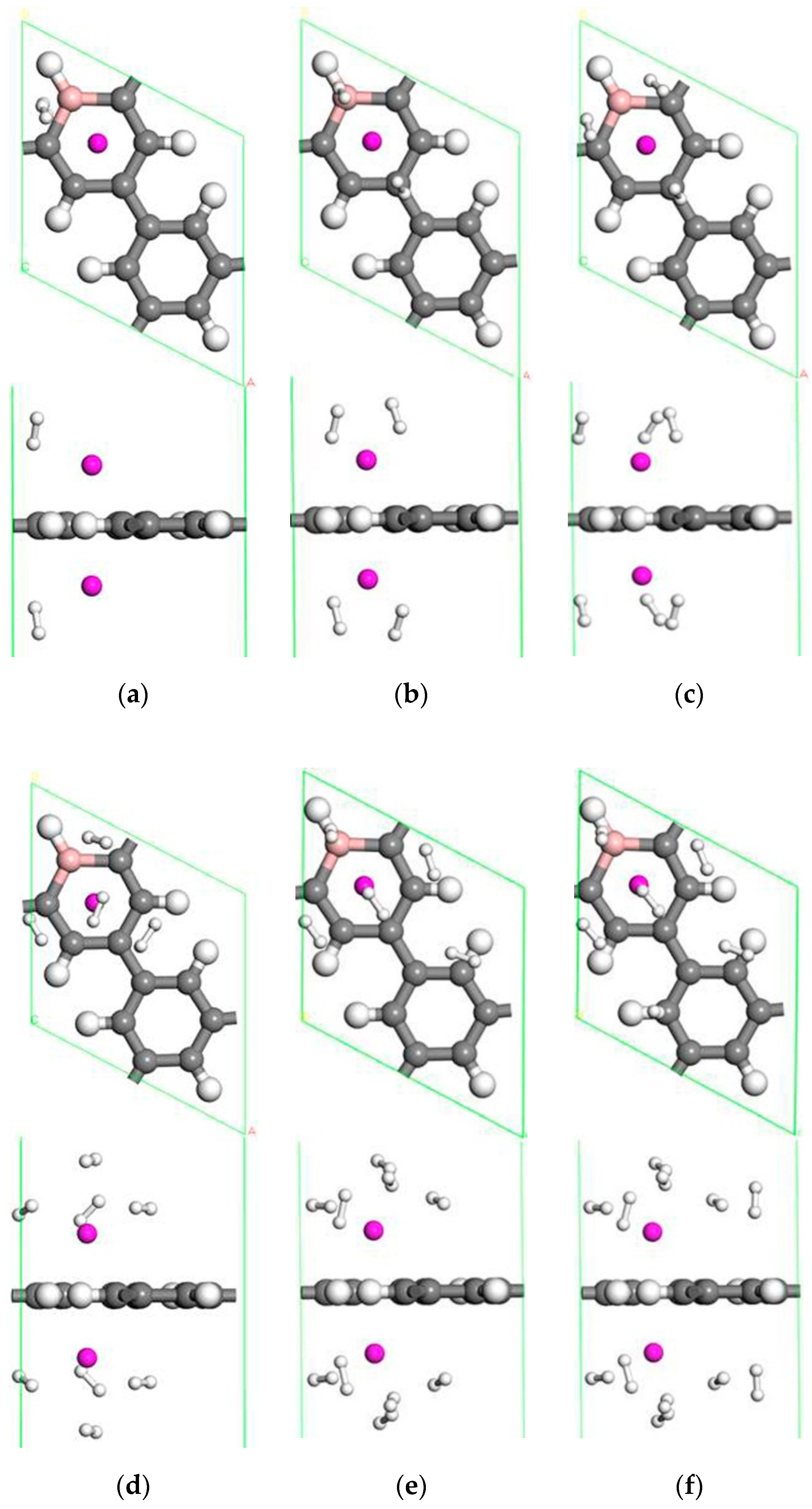
| 1B/PG | 2B/PG | 3B/PG | 4B/PG | 5B/PG | 6B/PG | |
|---|---|---|---|---|---|---|
| Top View |  |  |  |  |  |  |
| a (Å) | 7.57 | 7.62 | 7.72 | 7.79 | 7.88 | 7.95 |
| (Å) | 1.19 | 1.19 | 1.20 | 1.19 | 1.20 | 1.21 |
| (meV/atom) | 121.30 | 168.03 | 247.61 | 291.03 | 377.73 | 440.99 |
| Number of H2 | 1H2 | 2H2 | 3H2 | 4H2 | 5H2 |
|---|---|---|---|---|---|
| (eV) | −0.677 | −0.682 | −0.416 | −0.614 | −0.187 |
| (eV) | −0.677 | −0.680 | −0.592 | −0.597 | −0.515 |
| (Å) | 2.034 | 2.049 | 2.146 | 2.061 | 2.867 |
| (Å) | 2.274 | 2.229 | 2.380 | 2.333 | 2.385 |
| System | B-PG | Sc-B/PG | 1H2 | 2H2 | 3H2 | 4H2 | 5H2 |
|---|---|---|---|---|---|---|---|
| B-H | 1.06 | 1.04 | 1.03 | 1.04 | 1.05 | 1.05 | 1.06 |
| B (e) | 0.33 | 0.04 | 0.04 | 0.03 | 0.06 | 0.06 | 0.05 |
| Sc (e) | None | 1.15 | 1.72 | 1.94 | 2.18 | 2.46 | 2.64 |
| H (e) | None | None | −0.17 | −0.16 | −0.13 | −0.16 | −0.10 |
© 2019 by the authors. Licensee MDPI, Basel, Switzerland. This article is an open access article distributed under the terms and conditions of the Creative Commons Attribution (CC BY) license (http://creativecommons.org/licenses/by/4.0/).
Share and Cite
Wang, J.; Chen, Y.; Yuan, L.; Zhang, M.; Zhang, C. Scandium Decoration of Boron Doped Porous Graphene for High-Capacity Hydrogen Storage. Molecules 2019, 24, 2382. https://doi.org/10.3390/molecules24132382
Wang J, Chen Y, Yuan L, Zhang M, Zhang C. Scandium Decoration of Boron Doped Porous Graphene for High-Capacity Hydrogen Storage. Molecules. 2019; 24(13):2382. https://doi.org/10.3390/molecules24132382
Chicago/Turabian StyleWang, Jing, Yuhong Chen, Lihua Yuan, Meiling Zhang, and Cairong Zhang. 2019. "Scandium Decoration of Boron Doped Porous Graphene for High-Capacity Hydrogen Storage" Molecules 24, no. 13: 2382. https://doi.org/10.3390/molecules24132382
APA StyleWang, J., Chen, Y., Yuan, L., Zhang, M., & Zhang, C. (2019). Scandium Decoration of Boron Doped Porous Graphene for High-Capacity Hydrogen Storage. Molecules, 24(13), 2382. https://doi.org/10.3390/molecules24132382






